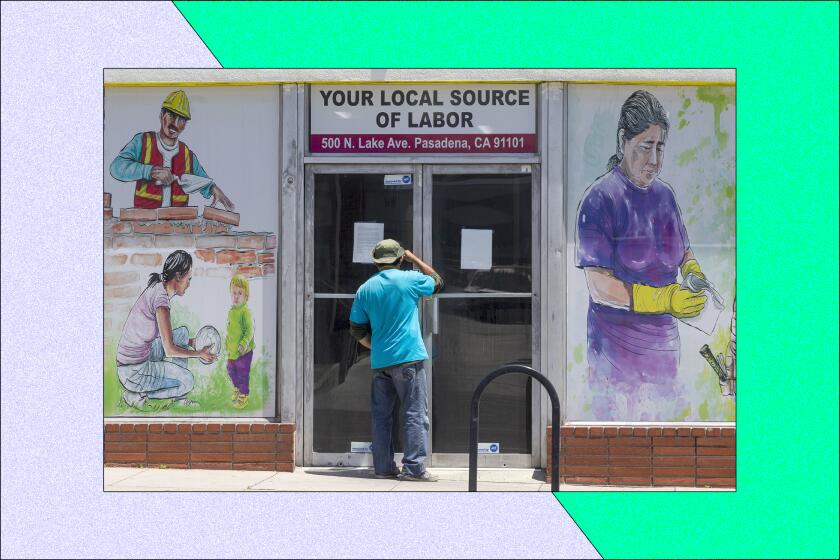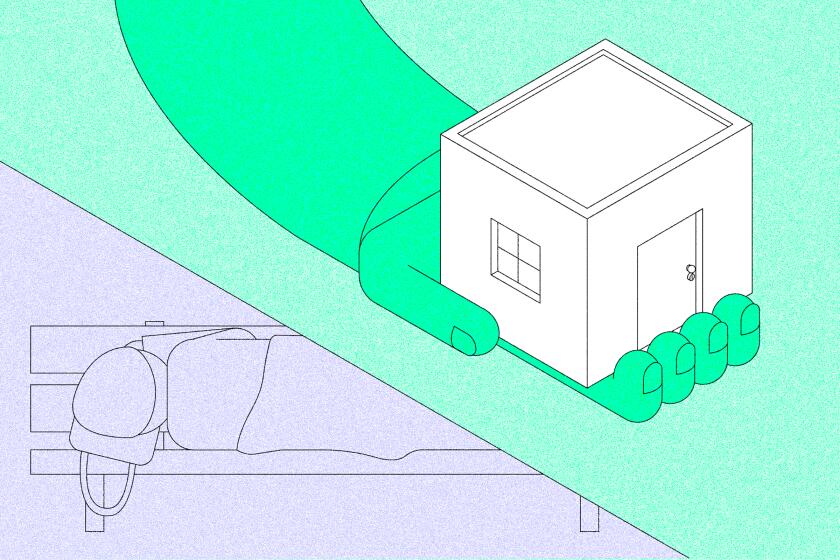Editorial: Want single-payer? California needs a public option first

- Share via
You couldn’t design a better stress test for the healthcare system than the COVID-19 pandemic. And on some fundamental levels, the system failed — witness, for example, the racial and ethnic disparities in outcomes that the virus laid bare.
Most fundamentally, the disease and the resulting shutdowns caused millions of Californians to lose their jobs, and in many cases, their employer-sponsored health insurance. And there couldn’t have been a worse time to lose one’s coverage than in the midst of a deadly pandemic.
Solving the insurance problem won’t fix everything that’s wrong with the healthcare system, but it’s a prerequisite to almost every other needed improvement. That’s because for all but the wealthiest Americans, insurance is key to care in this country. It’s simply too expensive otherwise. Unfortunately, insurance itself is rapidly becoming unaffordable too.
The solution seems clear to many progressives: Replace the hodgepodge of public and private insurance coverage with one government-provided plan that covers everyone, financed by taxpayers. This “single-payer” approach would guarantee that everyone could afford the care they needed. It also would slash the billing, collection and paperwork costs that are an albatross in the current system, while giving the government the power to cap overall healthcare spending as it strives to match resources to needs. And it would prevent private insurers from acting as gatekeepers to care and siphoning profits out of the system.
Converting to a single-payer system would cause enormous upheaval, however, and the Legislature has balked at bills to mandate it. Instead, in 2019 it created the Healthy California for All Commission to study its feasibility. That work is starting to bear fruit.
A recent analysis for the commission by Rick Kronick of UC San Diego concluded, as many other researchers have found, that a single-payer system would cost less overall than the current system. That’s not to say that the transition would be painless; having the government pick up the tab for all the costs now borne by individuals and employers would require an enormous increase in taxes, even as premiums and out-of-pocket costs would evaporate.
The same report by Kronick, however, identified an insurmountable hurdle: A single-payer system in California would almost certainly require an act of Congress to let the state funnel Medicare and Medicaid dollars, veterans’ health benefits and other federal and corporate health insurance contributions into a new, unified insurance system. And single-payer advocates don’t have enough votes among Democrats to overcome unified Republican opposition.
The division among congressional Democrats reflects the tradeoffs a single, government-run insurance plan would create, such as how hard it may be to address the biggest factor behind high and growing healthcare costs: not the profits made by insurers, but the prices charged by doctors and hospitals for care, which are far higher here than in other countries. When politicians take steps to rein in those costs — for example, as in the Medicare “cuts” in the Affordable Care Act that slowed the growth of payments to providers — they take a pounding from the voters. That helps explain why Medicare spending per enrollee is projected to grow more than 50% this decade.
As countries around the world have shown, however, there are ways to make a single-payer plan work, and we need to keep exploring how to do that. In the meantime, though, California should focus on the steps it can take to close the insurance gaps that COVID-19 revealed.
In the year before the pandemic, a little less than half of Americans and Californians were covered by employer-sponsored insurance, according to a Kaiser Family Foundation report. One benefit of this kind of coverage, particularly when it’s from a large employer, is that it groups individual consumers into pools, with risks and costs spread out among people of varying ages and conditions. That holds down premiums for people who need expensive care, which at some point in our lives is pretty much all of us. And under federal law, people covered by employer plans can’t lose their coverage or be charged higher premiums because of their health problems.
But this coverage is fragile because it’s tied to your job, not to you. The Affordable Care Act — which created state marketplaces where people without employer-sponsored insurance could shop for policies, aided by federal subsidies for low- and moderate-income households — was a big step forward. Crucially, it requires insurers to treat these markets the same way they treat large employer plans: No one can be turned away, all major health conditions have to be covered and no one’s premiums can be affected by their preexisting conditions. Instead, enrollees are pooled by geographic area, with risks and costs spread across everyone in the market.
Coverage has been expensive, however, in part because the policies are comprehensive; for many moderate-income Americans, especially families, the combination of premiums, deductibles and out-of-pocket costs has rendered care unaffordable. The response by state and federal lawmakers has been to provide more premium subsidies, but the boost is temporary at this point and doesn’t help with the increase in deductibles, which have risen to $4,000 for the benchmark “silver 70” plan in California’s marketplace, Covered California.
Beyond that, subsidies treat the symptoms of high healthcare costs instead of the problem itself. A better, more sustainable answer is to confront the forces pushing up healthcare spending, most notably the lack of competition. Consolidation among hospitals and some medical groups and a shortage of healthcare professionals have given too many providers the power to set high prices in too many regions. The state needs tools to counter that excessive power.
One possibility is for the state to compete with private insurers by providing a public option: opening Medi-Cal, the state’s version of Medicaid, to all state residents. The state pays doctors and hospitals much less to care for Medi-Cal patients than private insurers and even Medicare does, so expanding Medi-Cal could pressure insurers and healthcare professions to lower prices, improve services and innovate.
It would also take some doing — and no small amount of dollars — to make Medi-Cal an attractive alternative to employer-sponsored insurance and the private plans offered through Covered California. For starters, the state may have to bump up the rock-bottom fees it pays for care in order to attract more doctors, while also finding a way to let workers shift their employer’s financial contribution from the company’s group policy into the state’s plan. But the enormous amount of money the state spends on healthcare — including about $120 billion per year on Medi-Cal — gives it leverage when trying to persuade providers to get on board.
Opening Medi-Cal to all could be enormously disruptive, which is why much of the healthcare industry opposes a public option. But if ever a system needed disrupting, it’s this one.
Another possibility is for the state to use its regulatory power to try to make insurance and care more affordable. Gov. Gavin Newsom has called for a new state Office of Healthcare Affordability that would set healthcare spending goals for regions across the state, then apply increasing amounts of pressure to insurers and providers to meet those goals. Less draconian than simply dictating what prices doctors, hospitals and insurers could charge, this approach would encourage the industry to attack wasteful and unnecessary treatments, tests and procedures.
The catch, however, is that political leaders would need to show the courage of the office’s convictions. And historically, elected officials have wilted in the face of opposition from the hospitals, drugmakers and healthcare companies that are major employers in their districts.
There’s at least one other difficulty that California lawmakers have to confront. The biggest group of uninsured Californians — by one estimate, nearly 40% of the state’s roughly 3.2 million uninsured — are immigrants who are in the country illegally and are ineligible for Medi-Cal and Covered California subsidies.
Although there is a powerful moral argument for insuring all Californians regardless of immigration status, doing so would be expensive for state taxpayers — the Legislative Analyst’s Office recently put the cost at $2.1 billion annually. But failing to insure these Californians is costly in its own way. They’re left to rely on expensive, inefficient treatment at emergency rooms, whose costs are borne by taxpayers and people with insurance. And their untreated illnesses take a toll on public health and productivity.
A public option, spending goals and expanded eligibility for subsidies aren’t perfect substitutes for a well-designed single-payer system, but they have one clear advantage: They’re doable. With the pandemic exposing deep flaws in how Californians are insured, it’s time not just for bold steps, but also achievable ones.
More to Read
A cure for the common opinion
Get thought-provoking perspectives with our weekly newsletter.
You may occasionally receive promotional content from the Los Angeles Times.



















